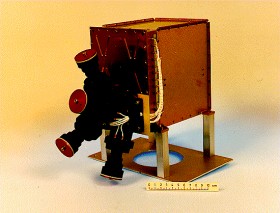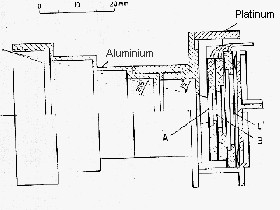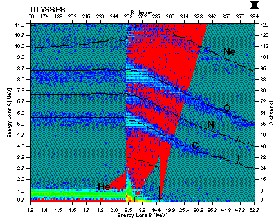|
ULYSSES
The EPAC Instrument
 The Energetic PArticles Composition instrument EPAC was designed to
provide information on the flux, anisotropy and
chemical composition of energetic particles in interplanetary space.
We decided to use four identical telescopes inclined under angles of
22.5°, 67.5°, 112.5° and 157.5°,
with respect to the spacecraft spin axis.
This design, together with spin sectorisation, allows us to sample 80% of the
sphere in 32 bins and therefore get a fully three-dimensional resolution of
anisotropies.
In each of the telescopes we used the
so-called "E-dE/dx" technique,
which requires a particle to traverse a very thin detector and then stop it in
a second, much thicker detector. Particles of higher energies can traverse
the two detector stack, but are eliminated by a third "veto" detector.
Each telescope has a geometric factor of about 0.08
cm²sr and has a field-of-view with a full angle of 35°.
The Energetic PArticles Composition instrument EPAC was designed to
provide information on the flux, anisotropy and
chemical composition of energetic particles in interplanetary space.
We decided to use four identical telescopes inclined under angles of
22.5°, 67.5°, 112.5° and 157.5°,
with respect to the spacecraft spin axis.
This design, together with spin sectorisation, allows us to sample 80% of the
sphere in 32 bins and therefore get a fully three-dimensional resolution of
anisotropies.
In each of the telescopes we used the
so-called "E-dE/dx" technique,
which requires a particle to traverse a very thin detector and then stop it in
a second, much thicker detector. Particles of higher energies can traverse
the two detector stack, but are eliminated by a third "veto" detector.
Each telescope has a geometric factor of about 0.08
cm²sr and has a field-of-view with a full angle of 35°.
 As a front detector we used an very thin semiconductor detector with a
thickness of 5 µm and 25 mm² sensitive area
(detector A).
Such detectors became available in reliable
technique by the time when we started to build the instrument. The energy
detector B was 100 µm thick. A third detector (C) of much larger area
provided veto signals from penetrating particles. The detector stack is
surrounded by a massive platinum shield. Further background rejection is
realised by using multiparameter analysis.
The front detectors are protected against sunlight by 80 µg/cm²
Al-layers.
By using hybrid electronic
technology we were able to make this fairly complicated instrument
with very low weight (2685 g) and power demand (3.43 W).
As a front detector we used an very thin semiconductor detector with a
thickness of 5 µm and 25 mm² sensitive area
(detector A).
Such detectors became available in reliable
technique by the time when we started to build the instrument. The energy
detector B was 100 µm thick. A third detector (C) of much larger area
provided veto signals from penetrating particles. The detector stack is
surrounded by a massive platinum shield. Further background rejection is
realised by using multiparameter analysis.
The front detectors are protected against sunlight by 80 µg/cm²
Al-layers.
By using hybrid electronic
technology we were able to make this fairly complicated instrument
with very low weight (2685 g) and power demand (3.43 W).
 The telescopes based on this design allowed clear separation of Hydrogen,
Helium and the heavier nuclei up to iron. The
Event-Data-Plot shows an example of such measurements in interplanetary
space in a plot, where the energy losses in detector A have been plotted
against those in detector B (x-axis). All four telescopes operate
in a self-calibrating mode, where particle tracks can be used to obtain
absolute calibrations.
The telescopes based on this design allowed clear separation of Hydrogen,
Helium and the heavier nuclei up to iron. The
Event-Data-Plot shows an example of such measurements in interplanetary
space in a plot, where the energy losses in detector A have been plotted
against those in detector B (x-axis). All four telescopes operate
in a self-calibrating mode, where particle tracks can be used to obtain
absolute calibrations.
14 different categories of data are transmitted to the ground, using different
time and angular resolutions for the various categories. In flight a functional
performance test using a pulse generator, which on command produced sequences
of coincident and non-coincident pulses is initiated from time to time. The
sensor was designed to operate at temperatures between +10°C near Earth
and -35°C at Jupiter.
On October 19, 1990 the instrument was turned on for the first time; it stayed
on since then and has delivered its data. About 30 papers have been written on
the interpretation of the measurements, and more than 50 talks have been given
at international conferences. Scientists involved in the project are
E. Keppler, A. Korth, M. Fränz, N. Krupp, M.K. Reuss, R. Seidel, U. Lauth,
J.B. Blake, J.J. Quenby, B.F. Drolias, X. Moussas, M. Yamauchi.
 ULYSSES EPAC Publications ULYSSES EPAC Publications
|
